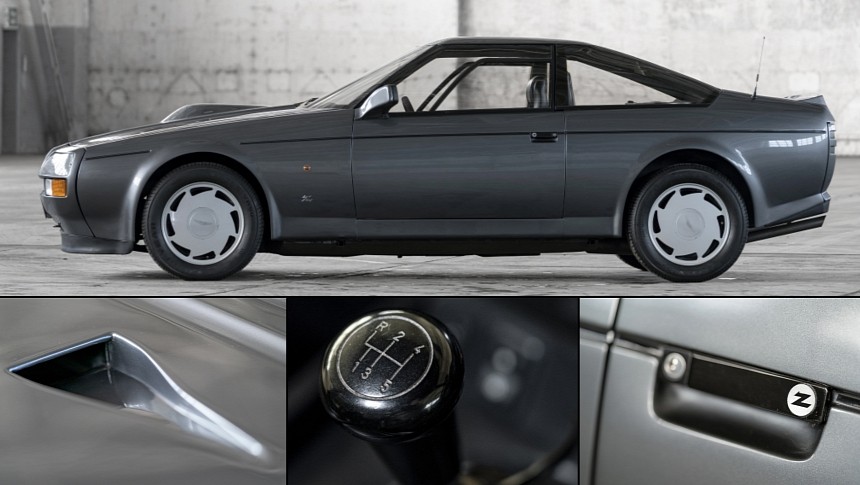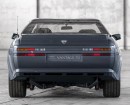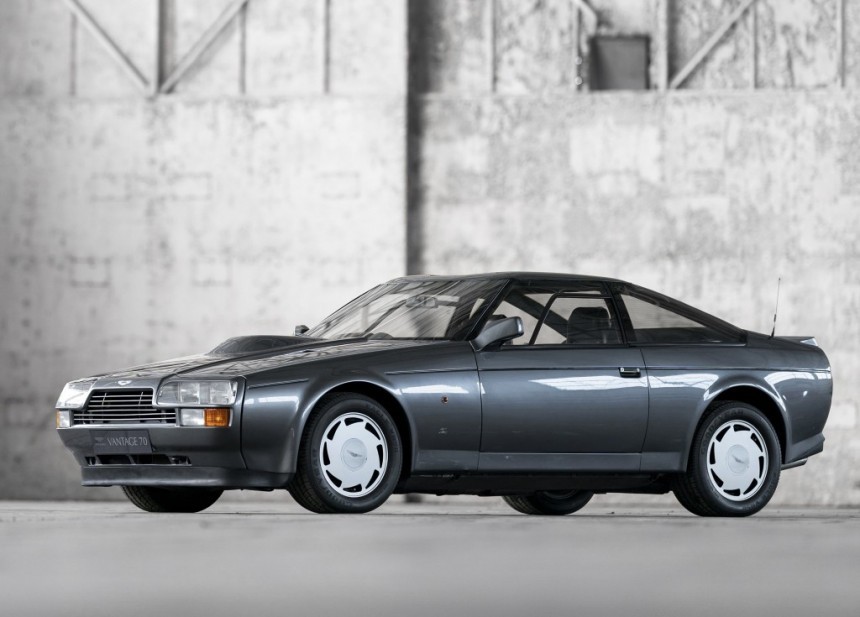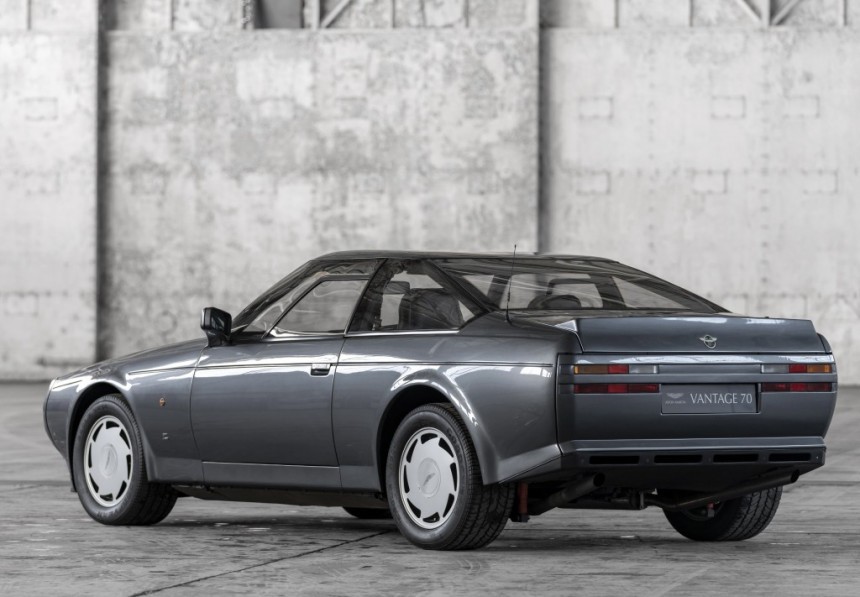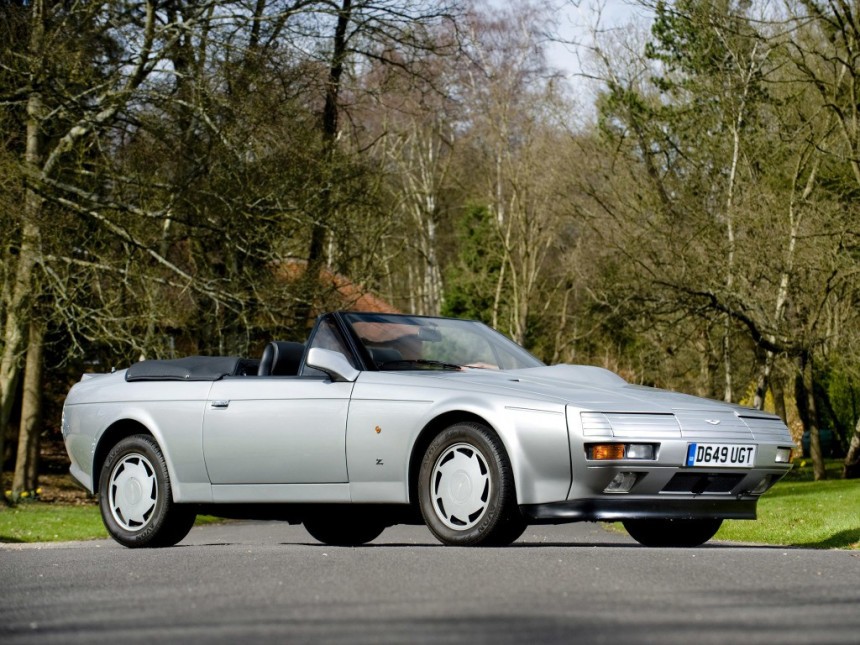Aston Martin's first-ever V8 was developed in the 1960s by Polish engineer Tadeusz Marek, the gentleman who's also credited with the inline-six lump of the DBR2 racing car. Produced from 1969 to 2000, the naturally-aspirated eighter launched with 5.3 liters to its name in the Aston Martin DBS, renamed to V8 in 1973 due to Aston Martin's canning of the six-cylinder model.
The British automaker stopped V8 production altogether in 1989. Be that as it may, the Zagato-bodied V8 lived on through 1990. Founded by Ugo Zagato in 1919, the Milanese coachbuilder started a very constructive relationship with Aston Martin back in 1960 at the Geneva Motor Show. The masterminds behind this iconic pairing were big kahuna David Brown, technical director John Wyer, and Ugo's son Gianni Zagato.
These men struck a deal that led to the creation of the first Zagato-bodied Aston Martin, the oh-so-pretty DB4 GT Zagato that originally numbered 20 units. More than two decades later, the Italians and Brits joined forces once again for the V8 Vantage Zagato. Decidedly squarer than its predecessor, the boxy coupe was later spun off into the V8 Volante Zagato. Owners of the convertible were offered the possibility of converting to Vantage specification, which included a bit more oomph and stylistic changes. The V580X engine – better known as the X-Pack in the V8 Vantage – could be furthered to 6.3 liters. In one case, it was bored out to 7.0 liters.
That said, how was the V8 Vantage Zagato brought into existence? It all started with Aston Martin's then-chairman Victor Gauntlett. Back in 1984, he and majority shareholder Peter Livanos met Gianni Zagato and his older brother Elio at the Geneva Motor Show. All four agreed on a very special take on the V8 Vantage, which called for very distinctive styling.
50 units were originally planned for production. Come 1985, design sketches of the V8 Vantage Zagato were presented to potential customers in Switzerland at the Geneva Motor Show. Every single car sold out, which prompted Aston Martin and Zagato to kick development into overdrive. Presented at the… wait for it… Geneva Motor Show in 1986, the V8 Vantage Zagato couldn't have launched at a worse time because the Italian coachbuilder was on the verge of going bankrupt.
When he learned of this, Gauntlett decided to purchase 50 percent of Carrozzeria Zagato. With that, he didn't only save Zagato but also made sure that every single V8 Vantage Zagato would be produced. Obviously more expensive than the V8 Vantage on which it was based, the more exotic sibling features a steel platform with a de Dion axle out back and independent suspension up front. Unequal wishbones, parallel trailing arms, coil springs, and Koni shock absorbers also need to be mentioned, plus a thicker anti-roll bar up front.
As opposed to the V8 Vantage, the Zagato makes do without 20-millimeter spacers out back. It also sits closer to the ground and rides a bit harsher due to a stiffer suspension setup. Aston Martin also switched from the V8 Vantage's fuel tank to a smaller unit, and the Speedline alloys are unique to the Zagato.
The 16-inch wheels are designed to cool the ventilated front rotors, which measure 267 millimeters in diameter. At the other end of the car, the discs are mounted inboard. As you're well aware, inboard brakes are no longer employed in this industry due to harder servicing. On the other hand, they do have two big advantages over their outboard cousins. Not only do inboard brakes lower unsprung mass, but this design also benefits the car's ride quality and the way said car handles.
Even though it retains the wheelbase of the V8 Vantage, the stubby rear end of the Zagato reduces drag. The aluminum-bodied model features composite front and rear bumpers, two NACA ducts in the hood, and a power bulge that flanks the aforementioned ducts. Those aren't styling-for-styling's-sake additions, though. Under the hood, you'll find the V580X engine from the V8 Vantage gulping air and gasoline through four downdraft carbs from the best name in the biz.
The Weber 48s are joined by large inlet ports, Cosworth-supplied pistons, and high-lift camshafts for plenty of gusto. How plenty? Think 432 horsepower at 6,200 revolutions per minute and 395 pound-feet (536 Nm) of torque at 5,100 revolutions per minute. 170 kilograms (375 pounds) lighter than the V8 Vantage, the Zagato came standard with a five-speed manual. Fewer than 10 units were optioned with a torque-converter auto.
The V8 Volante Zagato followed suit in March 1987 at the Geneva Motor Show, with Aston Martin announcing a production run of 25 examples. The convertible didn't get the coupe's more powerful engine for a rather simple reason, that being not to upset coupe customers.
As expected, hacking the roof clean off in favor of a soft top meant that Aston Martin had to reinforce the chassis. That's why the convertible is 35 kilograms (77 pounds) heavier, which may not seem like much at first glance. On the other hand, bear in mind that its V585 engine isn't as macho either due to electronic fuel injection.
The V8 Volante Zagato ended production after 35 customer vehicles were completed, not the original 25 promised by the British automaker. 10 of them are known to have received the Vantage specification with the pokier carbureted V8. The coupe numbers 50 customer vehicles, split between 21 units finished in left-hand drive and 29 units in right-hand drive.
These men struck a deal that led to the creation of the first Zagato-bodied Aston Martin, the oh-so-pretty DB4 GT Zagato that originally numbered 20 units. More than two decades later, the Italians and Brits joined forces once again for the V8 Vantage Zagato. Decidedly squarer than its predecessor, the boxy coupe was later spun off into the V8 Volante Zagato. Owners of the convertible were offered the possibility of converting to Vantage specification, which included a bit more oomph and stylistic changes. The V580X engine – better known as the X-Pack in the V8 Vantage – could be furthered to 6.3 liters. In one case, it was bored out to 7.0 liters.
That said, how was the V8 Vantage Zagato brought into existence? It all started with Aston Martin's then-chairman Victor Gauntlett. Back in 1984, he and majority shareholder Peter Livanos met Gianni Zagato and his older brother Elio at the Geneva Motor Show. All four agreed on a very special take on the V8 Vantage, which called for very distinctive styling.
50 units were originally planned for production. Come 1985, design sketches of the V8 Vantage Zagato were presented to potential customers in Switzerland at the Geneva Motor Show. Every single car sold out, which prompted Aston Martin and Zagato to kick development into overdrive. Presented at the… wait for it… Geneva Motor Show in 1986, the V8 Vantage Zagato couldn't have launched at a worse time because the Italian coachbuilder was on the verge of going bankrupt.
When he learned of this, Gauntlett decided to purchase 50 percent of Carrozzeria Zagato. With that, he didn't only save Zagato but also made sure that every single V8 Vantage Zagato would be produced. Obviously more expensive than the V8 Vantage on which it was based, the more exotic sibling features a steel platform with a de Dion axle out back and independent suspension up front. Unequal wishbones, parallel trailing arms, coil springs, and Koni shock absorbers also need to be mentioned, plus a thicker anti-roll bar up front.
As opposed to the V8 Vantage, the Zagato makes do without 20-millimeter spacers out back. It also sits closer to the ground and rides a bit harsher due to a stiffer suspension setup. Aston Martin also switched from the V8 Vantage's fuel tank to a smaller unit, and the Speedline alloys are unique to the Zagato.
The 16-inch wheels are designed to cool the ventilated front rotors, which measure 267 millimeters in diameter. At the other end of the car, the discs are mounted inboard. As you're well aware, inboard brakes are no longer employed in this industry due to harder servicing. On the other hand, they do have two big advantages over their outboard cousins. Not only do inboard brakes lower unsprung mass, but this design also benefits the car's ride quality and the way said car handles.
Even though it retains the wheelbase of the V8 Vantage, the stubby rear end of the Zagato reduces drag. The aluminum-bodied model features composite front and rear bumpers, two NACA ducts in the hood, and a power bulge that flanks the aforementioned ducts. Those aren't styling-for-styling's-sake additions, though. Under the hood, you'll find the V580X engine from the V8 Vantage gulping air and gasoline through four downdraft carbs from the best name in the biz.
The Weber 48s are joined by large inlet ports, Cosworth-supplied pistons, and high-lift camshafts for plenty of gusto. How plenty? Think 432 horsepower at 6,200 revolutions per minute and 395 pound-feet (536 Nm) of torque at 5,100 revolutions per minute. 170 kilograms (375 pounds) lighter than the V8 Vantage, the Zagato came standard with a five-speed manual. Fewer than 10 units were optioned with a torque-converter auto.
The V8 Volante Zagato followed suit in March 1987 at the Geneva Motor Show, with Aston Martin announcing a production run of 25 examples. The convertible didn't get the coupe's more powerful engine for a rather simple reason, that being not to upset coupe customers.
As expected, hacking the roof clean off in favor of a soft top meant that Aston Martin had to reinforce the chassis. That's why the convertible is 35 kilograms (77 pounds) heavier, which may not seem like much at first glance. On the other hand, bear in mind that its V585 engine isn't as macho either due to electronic fuel injection.
The V8 Volante Zagato ended production after 35 customer vehicles were completed, not the original 25 promised by the British automaker. 10 of them are known to have received the Vantage specification with the pokier carbureted V8. The coupe numbers 50 customer vehicles, split between 21 units finished in left-hand drive and 29 units in right-hand drive.
